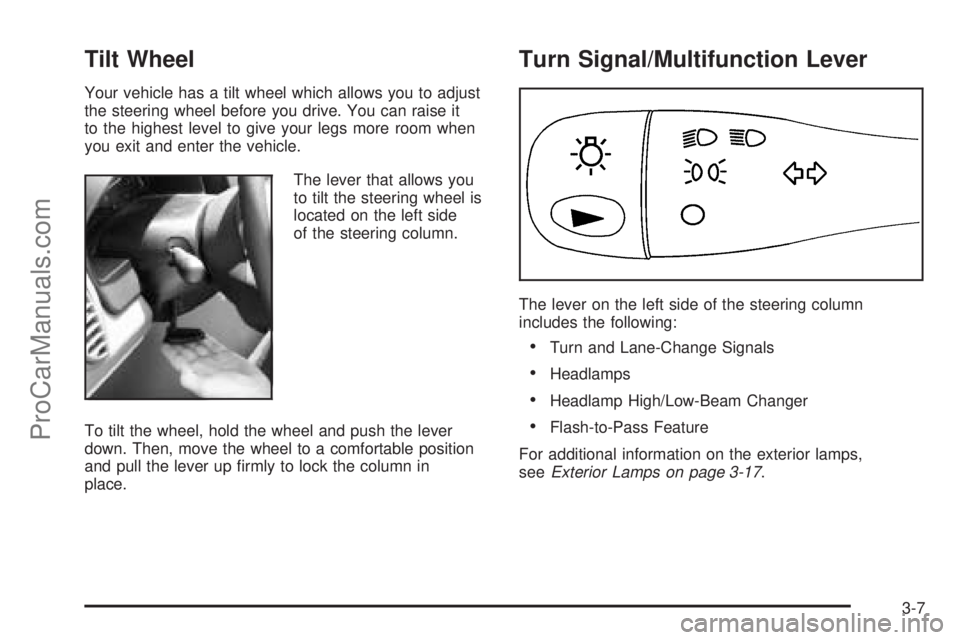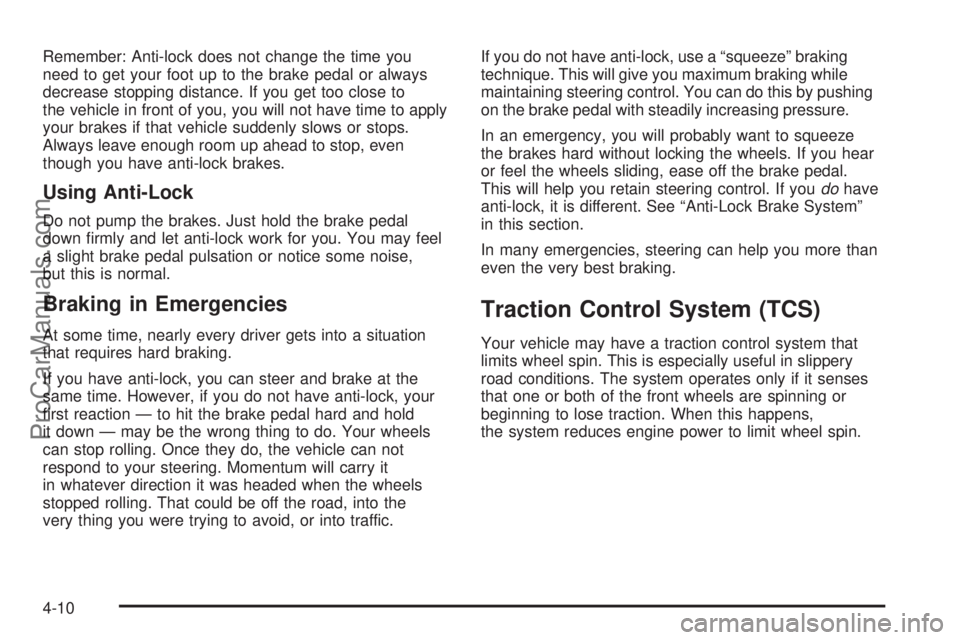2004 SATURN VUE steering
[x] Cancel search: steeringPage 111 of 392

Tilt Wheel
Your vehicle has a tilt wheel which allows you to adjust
the steering wheel before you drive. You can raise it
to the highest level to give your legs more room when
you exit and enter the vehicle.
The lever that allows you
to tilt the steering wheel is
located on the left side
of the steering column.
To tilt the wheel, hold the wheel and push the lever
down. Then, move the wheel to a comfortable position
and pull the lever up �rmly to lock the column in
place.
Turn Signal/Multifunction Lever
The lever on the left side of the steering column
includes the following:
Turn and Lane-Change Signals
Headlamps
Headlamp High/Low-Beam Changer
Flash-to-Pass Feature
For additional information on the exterior lamps,
seeExterior Lamps on page 3-17.
3-7
ProCarManuals.com
Page 113 of 392

The exterior lamp control has the following three
positions:
9(Off) (Base Level Only):Turn the control to this
position to turn off exterior lamps.
AUTO (Uplevel Only):If equipped, turn the control
to this position to put the headlamps in automatic mode.
AUTO mode will turn the exterior lamps on and off
depending upon how much light is available outside of
the vehicle.
;(Parking Lamps):Turn the control to this
position to turn on the parking lamps together with
the following:
Sidemarker Lamps
Taillamps
License Plate Lamps
Instrument Panel Lights
53(Headlamps):Turning the control to this
position turns on the headlamps, together with the
previously listed lamps and lights.
Lamps On Reminder
If you open the driver’s door with the ignition off and
the lamps on, you will hear a warning chime.
Windshield Wiper Lever
The lever on the right side of the steering column
operates the windshield wipers.
8:Pull the lever down and release it for a single
wiping cycle. The lever will return to its original
position. For more cycles, hold the lever down before
releasing it.
9:Put the lever in this position to turn off the wipers.
&:Put the lever in this position to set a delay
between wipes. Turn the band on the lever to set the
length of the delay (1, 2, or 3).
OO:Put the lever in this position for slow, steady
wiping cycles.
3-9
ProCarManuals.com
Page 115 of 392

Cruise Control (2.2L L4 Engine)
Your vehicle may be equipped with cruise control.
The buttons for the cruise control are located on the
steering wheel.
IO(Cruise On/Off):Push this button to turn the
system on and off.
IS(Resume/Accelerate):Push this button to
make the vehicle resume a previously set speed or to
accelerate when cruise is already active.
– (Set/Coast):Press this button to set the speed or to
decrease the speed when cruise is already active.With cruise control, you can maintain a speed of about
25 mph (40 km/h) or more without keeping your foot
on the accelerator. This can really help on long
trips. Cruise control does not work at speeds below
about 25 mph (40 km/h).
If you apply your brakes, the cruise control will shut off.
{CAUTION:
Cruise control can be dangerous where you
cannot drive safely at a steady speed. So, do
not use your cruise control on winding roads
or in heavy traffic.
Cruise control can be dangerous on slippery
roads. On such roads, fast changes in tire
traction can cause needless wheel spinning,
and you could lose control. Do not use cruise
control on slippery roads.
If your vehicle is in cruise control when the traction
control system begins to limit wheel spin, the cruise
control will automatically disengage. SeeTraction
Control System (TCS) on page 4-10. When road
conditions allow you to safely use it again, you may
turn the cruise control back on.
3-11
ProCarManuals.com
Page 118 of 392

Cruise Control (3.5L V6 Engine)
Your vehicle may be equipped with cruise control.
The buttons for the cruise control are located on the
steering wheel.
I(Cruise On/Off):Push this button to turn the
system on and off.
S(Resume/Accelerate):Push this button to make the
vehicle resume a previously set speed or to accelerate
when cruise is already active.
– (Set/Coast):Press this button to set the speed or to
decrease the speed when cruise is already active.With cruise control, you can maintain a speed of about
25 mph (40 km/h) or more without keeping your foot
on the accelerator. This can really help on long
trips. Cruise control does not work at speeds below
about 25 mph (40 km/h).
If you apply your brakes, the cruise control will shut off.
{CAUTION:
Cruise control can be dangerous where you
cannot drive safely at a steady speed. So, do
not use your cruise control on winding roads
or in heavy traffic.
Cruise control can be dangerous on slippery
roads. On such roads, fast changes in tire
traction can cause needless wheel spinning,
and you could lose control. Do not use cruise
control on slippery roads.
If your vehicle is in cruise control when the traction
control system begins to limit wheel spin, the cruise
control will automatically disengage. SeeTraction
Control System (TCS) on page 4-10.
3-14
ProCarManuals.com
Page 123 of 392

Interior Lamps
Instrument Panel Brightness
This feature controls the brightness of the instrument
panel lights.
The thumbwheel for this
feature is located on the
instrument panel to the left
of the steering column.
Turn the thumbwheel to the right to brighten the lights
or to the left to dim them.
Entry Lighting
If the dome lamp is in the DOOR position, the lamps
inside your vehicle will come on when any door is
opened. In addition, the lights will come on when the
remote keyless entry unlock button is pressed. It
will stay on for 20 seconds or until a door is opened.After the door is opened the lights will remain on and
stay on for 20 seconds after the doors are closed,
or until you put the key in the ignition and turn the key
to RUN. The lights will then gradually dim until it is
no longer lit.
Dome Lamp
The dome lamp switch has three positions.
9(Off):The lamps will not come on as long as the
switch is in this position.
R(On):The lamps will stay on as long as the switch
is in this position.
DOOR:The lamps will come on when a door is
opened. See “Entry Lighting” for more information.
Cargo Lamp
The cargo lamp is located over the rear compartment.
It will come on if any door is opened or the dome lamp is
in the on position. See “Dome Lamp” previously.
Liftgate Lamps
The liftgate lamps are located on the bottom left and
right corner of the liftgate. They will come on when
the liftgate or any door is opened. The liftgate lamps can
be controlled by the dome lamp switch. See “Dome
Lamp” previously.
3-19
ProCarManuals.com
Page 181 of 392

Your Driving, the Road, and Your Vehicle..........4-2
Driver Behavior..............................................4-2
Driving Environment........................................4-2
Vehicle Design...............................................4-2
Defensive Driving...........................................4-3
Drunken Driving.............................................4-4
Control of a Vehicle........................................4-7
Braking.........................................................4-7
Traction Control System (TCS).......................4-10
All-Wheel Drive (AWD) System.......................4-12
Steering......................................................4-12
Off-Road Recovery.......................................4-15
Passing.......................................................4-15
Loss of Control.............................................4-16
Operating Your All-Wheel-Drive Vehicle
Off Paved Roads.......................................4-18
Driving at Night............................................4-30Driving in Rain and on Wet Roads..................4-32
City Driving..................................................4-35
Freeway Driving...........................................4-36
Before Leaving on a Long Trip.......................4-37
Highway Hypnosis........................................4-38
Hill and Mountain Roads................................4-38
Winter Driving..............................................4-40
If You Are Stuck: In Sand, Mud,
Ice or Snow..............................................4-44
Towing..........................................................4-46
Towing Your Vehicle.....................................4-46
Recreational Vehicle Towing...........................4-46
Loading Your Vehicle....................................4-49
Adding a Snow Plow or Similar Equipment.......4-54
Towing a Trailer...........................................4-55
Section 4 Driving Your Vehicle
4-1
ProCarManuals.com
Page 187 of 392

Control of a Vehicle
You have three systems that make your vehicle go where
you want it to go. They are the brakes, the steering, and
the accelerator. All three systems have to do their work at
the places where the tires meet the road.
Sometimes, as when you’re driving on snow or ice, it is
easy to ask more of those control systems than the tires
and road can provide. That means you can lose control
of your vehicle. SeeTraction Control System (TCS)
on page 4-10.
Braking
Braking action involvesperception timeand
reaction time.
First, you have to decide to push on the brake pedal.
That isperception time.Then you have to bring up your
foot and do it. That isreaction time.
Averagereaction timeis about 3/4 of a second. But
that is only an average. It might be less with one driver
and as long as two or three seconds or more with
another. Age, physical condition, alertness, coordination
and eyesight all play a part. So do alcohol, drugs
and frustration. But even in 3/4 of a second, a vehicle
moving at 60 mph (100 km/h) travels 66 feet (20 m).
That could be a lot of distance in an emergency,
so keeping enough space between your vehicle and
others is important.
And, of course, actual stopping distances vary greatly
with the surface of the road (whether it is pavement
or gravel); the condition of the road (wet, dry, icy); tire
tread; the condition of your brakes; the weight of
the vehicle and the amount of brake force applied.
4-7
ProCarManuals.com
Page 190 of 392

Remember: Anti-lock does not change the time you
need to get your foot up to the brake pedal or always
decrease stopping distance. If you get too close to
the vehicle in front of you, you will not have time to apply
your brakes if that vehicle suddenly slows or stops.
Always leave enough room up ahead to stop, even
though you have anti-lock brakes.
Using Anti-Lock
Do not pump the brakes. Just hold the brake pedal
down �rmly and let anti-lock work for you. You may feel
a slight brake pedal pulsation or notice some noise,
but this is normal.
Braking in Emergencies
At some time, nearly every driver gets into a situation
that requires hard braking.
If you have anti-lock, you can steer and brake at the
same time. However, if you do not have anti-lock, your
�rst reaction — to hit the brake pedal hard and hold
it down — may be the wrong thing to do. Your wheels
can stop rolling. Once they do, the vehicle can not
respond to your steering. Momentum will carry it
in whatever direction it was headed when the wheels
stopped rolling. That could be off the road, into the
very thing you were trying to avoid, or into traffic.If you do not have anti-lock, use a “squeeze” braking
technique. This will give you maximum braking while
maintaining steering control. You can do this by pushing
on the brake pedal with steadily increasing pressure.
In an emergency, you will probably want to squeeze
the brakes hard without locking the wheels. If you hear
or feel the wheels sliding, ease off the brake pedal.
This will help you retain steering control. If youdohave
anti-lock, it is different. See “Anti-Lock Brake System”
in this section.
In many emergencies, steering can help you more than
even the very best braking.
Traction Control System (TCS)
Your vehicle may have a traction control system that
limits wheel spin. This is especially useful in slippery
road conditions. The system operates only if it senses
that one or both of the front wheels are spinning or
beginning to lose traction. When this happens,
the system reduces engine power to limit wheel spin.
4-10
ProCarManuals.com